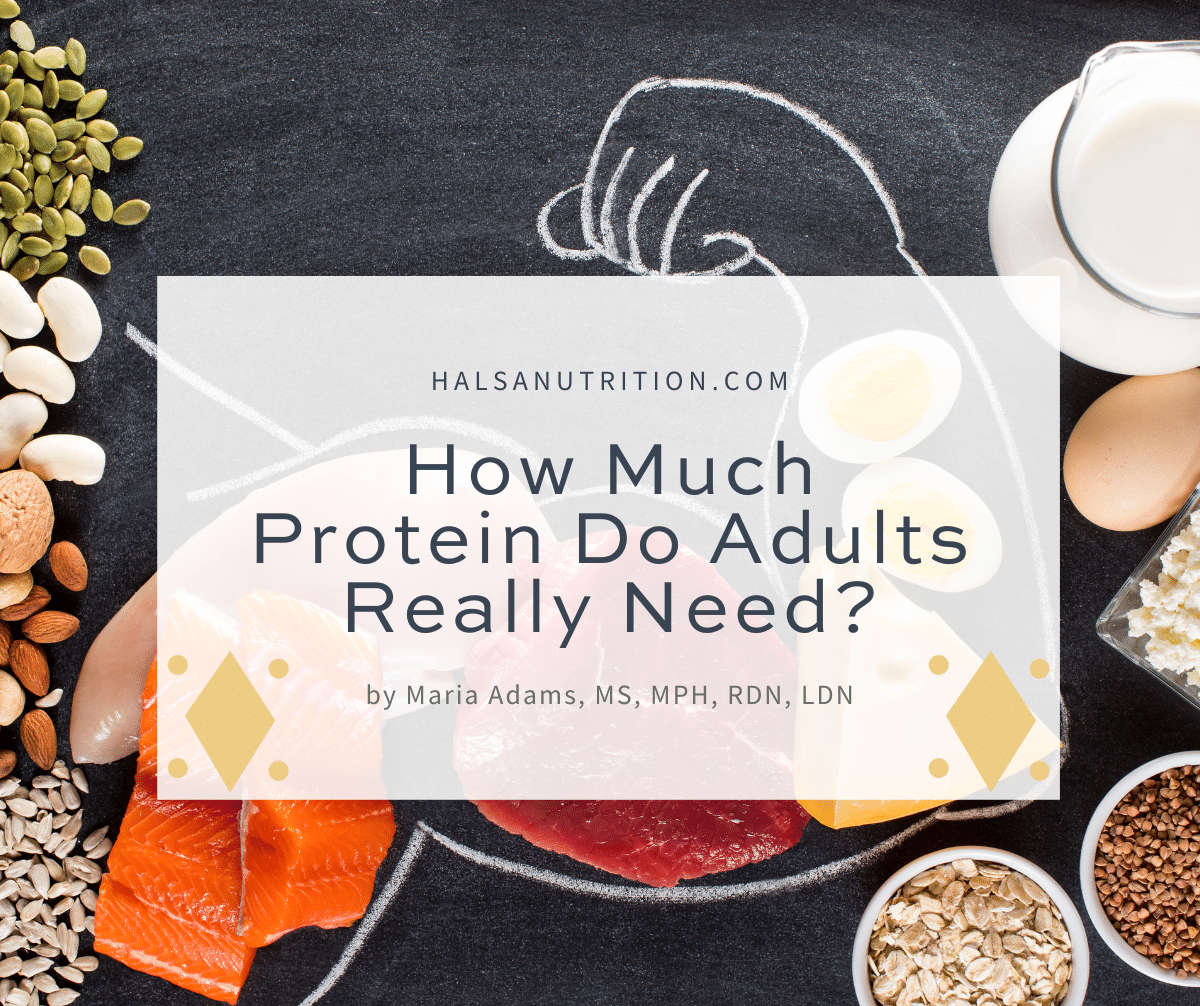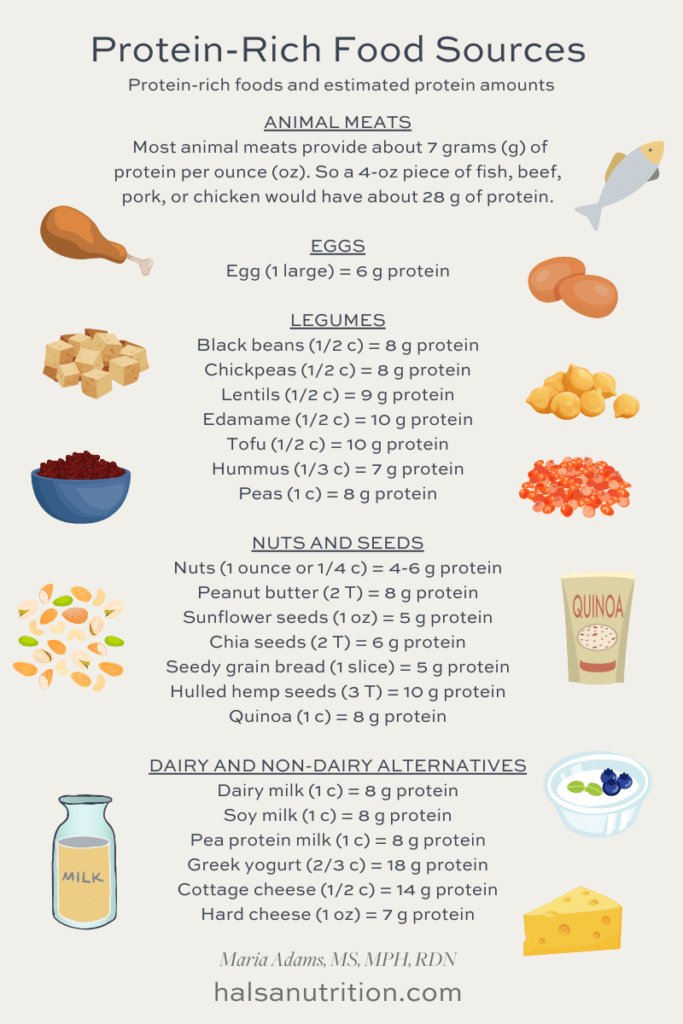
How Much Protein Do Adults Really Need?
Estimated reading time: 9 minutes
Protein is having a moment. Whether at the gym, hanging out with friends, or browsing social media, protein is a common topic. However, as usual, with nutrition, there is a lot of misinformation and confusion about how much we should consume,
How much protein do adults really need? (Do we really need 1 gram per pound, as some influencers are suggesting?) Is there a risk of getting too much protein? And how does focusing on protein affect intuitive eating? Read on to learn more.
How much protein do adults need?
The recommended daily allowance (RDA) for protein is 0.8 grams per kilogram daily (0.36 grams per pound) for healthy adults. This translates to 50 grams of protein for someone who weighs 140 pounds and 65 grams for someone weighing 180 pounds. Most Americans are currently meeting or exceeding these guidelines. That said, this is the minimum daily protein requirement; the latest research suggests that most adults benefit from a slightly higher intake than the RDA.
The International Society of Sports Nutrition recommends that athletes or individuals who exercise often consume 1.4-2.0 g/kg protein (0.63-0.9 g/lb). Depending on how heavy your training is, you will want to consume on the lower or higher end of this range.
If you don’t consider yourself particularly active, you may still benefit from a protein intake that’s a bit higher than the RDA, with some experts suggesting that healthy adults aim for 1–1.2 g/kg (0.45-0.55 g/lb). There’s also evidence suggesting that women in perimenopause or menopause may benefit from more protein, about 1-1.2 g/kg (0.45-0.55 g/lb). These recommendations suggest that a healthy adult weighing 150 pounds would need about 75 grams of protein per day. Note that women who are pregnant or breastfeeding also have higher protein needs than the RDA.
Muscle loss increases as we age, starting around age 40. Research, therefore, suggests a higher protein intake for elderly adults, with a recommended range of 1.2-2.0 g/kg (0.55-0.9 g/lb). This translates to 77-126 grams per day for someone who weighs 140 pounds and 99-162 grams per day for someone who weighs 180 pounds.
It should be highlighted that nutrition research is not perfect and always evolving. As the above research suggests, there is a lot of variability in recommendations. Moreover, humans are not robots, and it’s hard to determine someone’s exact protein needs. The right amount for you will depend on factors such as age, activity level, weight, stress, medical conditions, medications (including weight loss medications), and the overall composition of your diet. Most people will naturally get enough protein when they are eating a variety of foods and eating enough overall.

Does it matter when you eat protein?
Ideally, spread out your protein intake throughout the day. While it doesn’t have to be perfectly distributed (e.g., 25 grams in each meal and 15 grams in each snack), it makes sense to include protein-rich foods in your meals and snacks when possible. Of course, it’s also ok to eat meals or snacks with little or no protein–your body will naturally guide you to eating more later.
Your body uses protein throughout the day to repair and rebuild tissue. Protein helps slow digestion, which means that we stay full longer and have a more gradual increase in blood sugar. Additionally, protein (along with carbohydrates) is an important component of post-workout snacks and meals.
What are the risks of getting too much protein?
In the past, there were concerns that too much protein may damage kidneys or increase the risk of osteoporosis. However, the most recent research has debunked these notions, and it seems that healthy adults can safely consume higher levels of protein. (Note that people with certain medical conditions, for example, chronic kidney disease, may need to limit protein intake.)
That said, there are risks of eating too much protein and being overly focused on protein. From displacing other important nutrients to becoming too rigid with your diet to taking the joy out of eating, here are some common pitfalls of trying to eat more protein.
NUTRITION RISKS OF GETTING TOO MUCH PROTEIN
- Eating a high-protein diet may prevent us from getting enough other macronutrients. Protein is one of three essential macronutrients, the other two being carbohydrates and fats. Aim to include all three (protein + carbs + fats) in most meals and snacks. Current US guidelines recommend that adults get 10-35% of daily calories from protein, 20-35% from fat, and 45-65% from carbohydrates.
- When we get too focused on protein, carbs are generally the first to go. Carbs are not the enemy! They are the body’s preferred source of fuel and the macronutrient we need most. Include a variety of carbs in your diet. From bread to fruit to desserts, there is a place for all your favorite carbs.
- Speaking of carbs, be sure to include whole grains such as whole wheat, oats, brown rice, farro, spelt, barley, sorghum, and quinoa. Whole grains are an important source of vitamins, minerals, and fiber. As a bonus, they naturally contain more protein than their refined counterparts!
- Being overly focused on protein may also prevent people from eating enough fruits and vegetables. Research suggests that only 10% of people consume enough fruits and veggies. So don’t forget to include color (aka fruits and veggies) on your plate!
- It’s also essential to consume a variety of protein sources. While animal proteins tend to be higher in protein content and are considered “higher quality” because they are easier for our body to use, they can also be higher in saturated fat. Plant-based proteins are associated with health benefits and are often a more environmentally friendly option. While it’s beneficial to consume both types, getting enough protein on a vegetarian or vegan diet is possible.
RISKS OF BEING OVERLY FOCUSED ON PROTEIN INTAKE
- Being overly focused on protein can also make it harder to eat intuitively. While it can be helpful to have a goal range in mind when it comes to protein, getting too focused on eating enough protein can prevent us from listening to our body’s intuition. Our bodies are wise, and when we are eating intuitively, they will generally guide us to eating the right kinds and amounts of protein.
- When we rely too much on “guidelines” or tracking “macros,” we can become more rigid about our eating. This lack of flexibility can lead to stress and anxiety when we aren’t able to meet our goals or follow “the plan.”
- Being highly focused on protein intake can also mean that eating and nutrition take up a lot of valuable brain space. While it’s good to put thought into planning and preparing meals, it shouldn’t be the main focus of our days.
- Simply put, being overly focused on protein intake can zap the joy out of eating! While nutrition is important, eating should also be enjoyable, satisfying, and flexible.

Can you eat intuitively and still focus on protein?
So, is it possible to be an intuitive eater and still focus on protein?
It’s possible. But it’s also likely that focusing too much on protein intake will shift you away from eating intuitively. It’s hard to tune into what you really want for breakfast when your main focus is hitting a protein target. When we get too focused on protein intake (or any other nutrition parameter), it generally results in disordered eating*, which could lead the way to a full-blown eating disorder.
*Note that disordered eating exists on a spectrum, and it’s never too early to get help; eating should be joyful, not stressful. If you need support, please reach out to a Registered Dietitian who specializes in intuitive eating or eating disorders.
Most healthy adults don’t need to track their protein intake. A simpler method is to aim to include protein-rich foods, along with carbs and fat, at most meals and snacks. (Note the use of the word most–it’s totally ok to have a meal or snack with little or no protein.) Some people also find that using the plate method is helpful. The plate method suggests making half your plate fruits and veggies, a quarter of your plate grains and starches, and a quarter of your plate protein. Again, use this as a gentle, flexible guide, and know that all your meals and snacks don’t have to look like this!
Learn about foods high in protein and then choose a variety of them. But remember that it’s not just about the main characters–foods such as pasta and vegetables play supporting roles and help fulfill our total protein needs. Humans are omnivores, which means we can meet our nutritional needs by eating many different types of diets!
Combine this knowledge with your internal wisdom. What foods and amounts of food are pleasurable and satisfying to your body? What foods and amounts of food help you feel your best during the day or after a workout?
Suggestions for getting enough protein while still eating intuitively
- Include protein-rich food in your meals and snacks, most of the time. (Be flexible!)
- Educate yourself about what foods contain protein. A little nutrition knowledge is helpful. (See chart below).
- Listen to your body. When presented with a variety of nourishing foods, it will naturally guide you in getting enough protein.

Seek out a registered dietitian for more individualized support
If you could use more individualized guidance or support, contact a Registered Dietitian. Whether you’re an active adult looking to build muscle, a woman going through perimenopause, or an individual who wants to promote a healthy relationship with food while still meeting nutrition needs, a dietitian can help!
Other posts you might like
- How Much Protein Do Teens Need?
- Collagen Supplementation and Women’s Wellness: A Look at the Evidence
- Calorie Information: Helpful or Harmful?
- An Intuitive Eating Plate and Other Plate Models
- The Joy of Food: Why Eating for Health Isn’t Always the Most Important Thing
About the author
Maria Adams, MS, MPH, RDN, LDN, is a registered dietitian and Certified Intuitive Eating Counselor. Maria takes a weight-inclusive approach and helps individuals rediscover the joy of food, learn how to nourish to feel their best, and heal from chronic dieting and disordered eating. She holds a Bachelor of Science Degree in Nutrition Science, a Master of Science in Nutrition Communication, and a Master of Public Health.
Leave a Reply